Evolutionary Game on Government Regulation and Green Supply Chain Decision-Making
Abstract
1. Introduction
- (1)
- The government is added to the game between suppliers and manufacturers, and a three-party evolutionary game model is constructed.
- (2)
- To analytically identify the long-term decision-making about green behavior of the supply chain members from the perspective of internal factors or external environmental regulation.
- (3)
- To propose the effect of supply chain members’ strategies on government regulation. And the government environmental policy is optimized to encourage more suppliers and manufacturers to take green activities.
2. Literature Review
2.1. Static and Dynamic Game between Green Supply Chain Members
2.2. Influence of Government Intervention on Supply Chain Members’ Behavior
2.3. Applications of System Dynamics (SD) in Analyzing Supply Chain Members’ Behavior
2.4. Research Gaps and Contributions to Literature
3. Model Formulation
3.1. Assumptions and Notations
- i.
- When the suppliers adopt green behavior and the manufacturers keep non-green behavior, the unit cost for non-green manufacturers is;
- ii.
- When the suppliers offer non-green raw materials or components while the manufacturers adopt green strategy, the unit cost for green manufacturers is;
- iii.
- When both the suppliers and the manufacturers choose to perform green behaviors, the cost of manufacturers is;
- iv.
- When both the suppliers and the manufacturers choose to perform non-green behaviors, the cost of manufacturers is.
- i.
- If the suppliers and manufacturers are both non-green, the products offered by the supply chain is also non-green, and the final price is regarded as;
- ii.
- If the suppliers and manufacturers both implement green activity, the final price is;
- iii.
- If only the suppliers adopt green behavior, the price is denoted as;
- iv
- If only the manufacturers adopt green behavior, the price is.
3.2. Basic Model
4. Model Analysis
4.1. Strategy Stability Analysis for Suppliers
- (1)
- when , and , so is the ESS;
- (2)
- when , and , so is the ESS.
4.2. Strategy Stability Analysis for Manufacturers
- (1)
- when , and , so is the ESS;
- (2)
- when , and , so is the ESS.
4.3. Strategy Stability Analysis for Governments
- (1)
- when , and , so is the ESS;
- (2)
- when , and , so is the ESS.
4.4. ESS Analysis for Participants
5. Numerical Simulation
5.1. Simulation Model Construction Based on SYSTEM Dynamics (SD)
- i.
- Suppose Company M implements recycling activity and procures environmentally friendly materials from Company S, the unit production cost is 700 CNY (~$99.9) and the final price is 2350 CNY (~$335);
- ii.
- If Company M does not consider green activity or procures non-green materials, the unit production cost and final price are 660 CNY (~$94.1) and 2190 CNY (~$313), respectively;
- iii.
- If Company M implements recycling activity but Company S offers non-green materials, the unit production cost and final price are 780 CNY (~$111) and 2280 CNY (~$325), respectively;
- iv.
- If Company M purchases environmentally friendly materials but does not embrace recycling strategy, it would spend 500 CNY (~$71.3) for unit production and selling at 2280 CNY (~$325).
5.2. Equilibrium Stability Analysis
5.3. Sensitivity Analysis
6. Conclusions and Management Implications
- (1)
- Suppliers’ strategy depends on production cost, reputation gained by green behavior and the government’s reward and punishment mechanism. Manufacturers’ strategy is influenced by production cost, retail price, reputation gained by green behavior and government reward and punishment mechanism. In particular, whether the cooperated supplier adopts green behavior affects the manufacturer’s production cost and the price of the final product, so manufacturer’s strategy is also related to supplier’s action. Reducing the cost of green raw materials (green production cost), increasing consumer acceptance of green products, and strengthening the rewards and punishments mechanism contribute to the evolution of suppliers and manufacturers to green behavior strategies.
- (2)
- The government’s strategy is related to the degree of incentives and penalties, supervision cost, and the cost of pollution treatment. When a high proportion of suppliers or manufacturers adopt green strategy, governments do not need to supervise them. On the contrary, if most of the suppliers or manufacturers maintain a non-green strategy, supervision and reward and punishment mechanism should be applied.
- (3)
- In the long-term game process, the strategies of suppliers, manufacturers and the governments change with the behavior of other groups. Under the condition that suppliers and manufacturers do not adopt green strategy and governments do not execute regulatory strategy, strengthening government’s regulation could promote suppliers to implement green production but the manufacturers will remain non-green as a free rider. If the suppliers adopt green strategy and the government carry out regulation, raising the probability of green decision-making for the non-green manufacturers leads to both the two enterprises groups finally take greening measures. Under this situation, reduction on the probability of regulatory behaviors will not affect the enterprises’ green behavior strategy.
- (4)
- The strategies of suppliers, manufacturers, and governments are related to the initial probability of themselves and other groups. For suppliers, high initial probability of their adopting green strategy lead to high evolution speed to green behavior of all group when the probability value of government regulation behavior is a constant. When government’s regulation is strengthened and a large number of suppliers implement green production, the manufacturers tend to keep non-green behavior. Both the strategies of suppliers and manufacturers affect governments’ evolutionary path and speed. Government’s regulation is taken when most suppliers and manufacturers do not adopt green strategy, and strengthening incentives and penalties could provoke enterprises to take green actions.
- (1)
- Immature eco-friendly production technology and high production cost are the main factors restricting enterprises to implement green activities, thus the government should increase the investment in new technology research and development, cultivating innovative and technical personnel, and providing subsidies for green enterprises.
- (2)
- The strategies of the enterprises (suppliers and manufacturers) and governments cannot reach an stable evolutionary point. Therefore, governments should focus on production behavior of enterprises and the development of green product market, so as to adjust existing mechanism to formulate the best possible reward and punishment regulation for suppliers and manufacturers to adopt green technology. More incentives should be provided for green enterprises and penalties should be strengthened for non-green enterprises.
- (3)
- When both the supplier and manufacturer in the supply chain are less likely to adopt green strategies, the government could first implement regulation on the manufacturer because the supplier will also be greener if its cooperating manufacturer adopts a green strategy after a long-term evolution process.
- (4)
- Governments are supposed to distinguish the non-green enterprises that are to be supervised and guided to carry out green production, thereby enhancing the proportion of green suppliers and manufacturers in their group. A high proportion of green enterprises contributes to accelerating the green product development.
- (5)
- The probability of the government regulation will decrease with the increase of governmental regulation cost, and vice versa. Therefore, the governments not only constantly improve their regulatory capability to monitor the production activity of enterprises enough, but also gradually reduce the supervision cost, and improve regulatory efficiency and effectiveness by formulating a more perfect information disclosure system and standardized enterprise green assessment system.
Author Contributions
Funding
Conflicts of Interest
Appendix A. Proof for Strategy Stability of Manufacturers
Appendix B. Proof for Strategy Stability of Governments
Appendix C. Proof of Proposition 1
References
- Gupta, S.; Palsule-Desai, O. Sustainable supply chain management: Review and research opportunities. IIMB Manag. Rev. 2011, 23, 234–245. [Google Scholar] [CrossRef]
- Bazan, E.; Jaber, M.Y.; Zanoni, S. Supply chain models with greenhouse gases emissions, energy usage and different coordination decisions. Appl. Math. Model. 2015, 39, 5131–5151. [Google Scholar] [CrossRef]
- Cao, J.; Zhang, X.M.; Hu, L.L.; Xu, J.Y.; Zhao, Y.W.; Zhou, G.G.; Schnoor, J.L. EPR regulation and reverse supply chain strategy on remanufacturing. Comput. Ind. Eng. 2018, 125, 279–297. [Google Scholar] [CrossRef]
- Ma, C.S.; Chen, X.; Luo, Z.Y. Production strategy of considering low carbon emission policies regulation under stochastics demand. Control Decis. 2015, 30, 969–976. [Google Scholar]
- Centobelli, P.; Cerchione, R.; Esposito, E. Environmental sustainability and energy-efficient supply chain management: A review of research trends and proposed guidelines. Energies 2018, 11, 275. [Google Scholar] [CrossRef]
- Sellitto, M.A.; Hermann, F.F.; Blezs, A.E. Describing and organizing green practices in the context of green supply chain management: Case studies. Resour. Conserv. Recycl. 2019, 145, 1–10. [Google Scholar] [CrossRef]
- Kumar, A.; Holuszko, M.; Espinosa, D.C.R. E-waste: An overview on generation, collection, legislation and recycling practices. Resour. Conserv. Recycl. 2017, 122, 32–42. [Google Scholar] [CrossRef]
- Ji, G.J.; Huang, W.W. Effective implementation of WEEE take-back directive. J. Manag. Sci. China 2012, 15, 1–9. [Google Scholar]
- Zhao, X.M.; You, J.J.; Li, Y.Q. The effect of government fund policy in promoting WEEE recycling. Chin. J. Manag. Sci. 2018, 26, 42–53. [Google Scholar]
- Li, C.F.; Zhu, L.M. Optimal recovery strategies of home appliance trade-in scheme under EPR. Oper. Res. Manag. Sci. 2017, 26, 67–75. [Google Scholar]
- Cao, J.; Xu, J.Y.; Wang, H.; Zhang, X.M.; Chen, X.H.; Zhao, Y.W.; Yang, X.L.; Zhou, G.G.; Schnoor, J.L. Innovating collection modes for waste electrical and electronic equipment in China. Sustainability 2018, 10, 1446. [Google Scholar] [CrossRef]
- Chatterjee, K.; Zufferey, D.; Nowak, M.A. Evolutionary game dynamics in populations with different learners. J. Theor. Biol. 2012, 301, 161–173. [Google Scholar] [CrossRef]
- Nimse, P.; Vijayan, A.; Kumar, A.; Varadarajan, C. A review of green product databases. Am. Inst. Chem. Eng. 2007, 26, 131–137. [Google Scholar] [CrossRef]
- Savaskan, R.C.; Bhattacharya, S.; Van Wassenhove, L.N. Closed-loop supply chain models with product remanufacturing. Manag. Sci. 2004, 50, 239–252. [Google Scholar] [CrossRef]
- Nagarajan, M.; Sošić, G. Game-theoretic analysis of cooperation among supply chain agents: Review and extensions. Eur. J. Oper. Res. 2008, 187, 719–745. [Google Scholar] [CrossRef]
- Nagurney, A.; Yu, M. Sustainable fashion supply chain management under oligopolistic competition and brand differentiation. Int. J. Prod. Econ. 2012, 135, 532–540. [Google Scholar] [CrossRef]
- Shi, P.; Yan, B.; Shi, S. Pricing and product green degree decisions in green supply chains with fairness concerns. Syst. Eng. Theory Pract. 2016, 36, 1937–1950. [Google Scholar]
- Bai, C.G.; Tang, J.F. Manufacturing-marketing green supply chain cooperative game analysis. J. Syst. Eng. 2017, 32, 818–828. [Google Scholar]
- Hong, Z.F.; Wang, H.; Yu, Y. Green product pricing with non-green product reference. Transp. Res. E 2018, 115, 1–15. [Google Scholar] [CrossRef]
- Song, H.; Gao, X. Green supply chain game model and analysis under revenue-sharing contract. J. Clean. Prod. 2018, 170, 183–192. [Google Scholar] [CrossRef]
- Taleizadeh, A.A.; Alizadeh-Basban, N.; Niaki, S.T.A. A closed-loop supply chain considering carbon reduction, quality improvement effort, and return policy under two remanufacturing scenarios. J. Clean. Prod. 2019, 232, 1230–1350. [Google Scholar] [CrossRef]
- Capraro, V.; Jagfeld, G.; Klein, R.; Mul, M.; Pol, I.V.D.; Van de Pol, I. Increasing altruistic and cooperative behaviour with simple moral nudges. Sci. Rep. 2019, 9, 11880. [Google Scholar] [CrossRef] [PubMed]
- Alboszta, J.; Miȩkisz, J. Stability of evolutionarily stable strategies in discrete replicator dynamics with time delay. J. Theor. Biol. 2004, 231, 175–179. [Google Scholar] [CrossRef] [PubMed]
- Barari, S.; Agarwal, G.; Zhang, W.J.; Mahanty, B.; Tiwari, M.K. A decision framework for the analysis of green supply chain contracts: An evolutionary game approach. Expert Syst. Appl. 2012, 39, 2965–2976. [Google Scholar] [CrossRef]
- Babu, S.; Mohan, U. An integrated approach to evaluating sustainability in supply chains using evolutionary game theory. Comput. Oper. Res. 2018, 89, 269–283. [Google Scholar] [CrossRef]
- Ji, S.F.; Zhao, D.; Luo, R.J. Evolutionary game analysis on local governments and manufacturers’ behavioral strategies: Impact of phasing out subsidies for new energy vehicles. Energy 2019, 189, 11064. [Google Scholar] [CrossRef]
- Bansal, S.; Gangopadhyay, S. Tax/subsidy policies in the presence of environmentally aware consumers. J. Environ. Econ. Manag. 2003, 45, 333–355. [Google Scholar] [CrossRef]
- Chen, Y.J.; Sheu, J.B. Environmental-regulation pricing strategies for green supply chain management. Transp. Res. E Logist. 2009, 45, 667–677. [Google Scholar] [CrossRef]
- Zhu, Q.H.; Dou, Y.J. A game model for green supply chain management based on government subsidies. J. Manag. Sci. China 2011, 14, 86–95. [Google Scholar]
- Krass, D.; Nedorezov, T.; Ovchinnikov, A. Environmental taxes and the choice of green technology. Prod. Oper. Manag. 2013, 22, 1035–1055. [Google Scholar] [CrossRef]
- Hafezalkotob, A. Competition of two green and regular supply chains under environmental protection and revenue seeking policies of government. Comput. Ind. Eng. 2015, 82, 103–114. [Google Scholar] [CrossRef]
- Wang, W.B.; Deng, W.W.; Bai, T. Design the reward-penalty mechanism for reverse supply chains based on manufacturers’ competition and carbon footprint constraints. J. Ind. Eng. 2016, 30, 188–194. [Google Scholar] [CrossRef]
- Ghosh, D.; Shah, J. A comparative analysis of greening policies across supply chain structures. Int. J. Prod. Econ. 2012, 135, 568–583. [Google Scholar] [CrossRef]
- Yang, D.X.; Chen, Z.Y.; Nie, P.Y. Output subsidy of renewable energy power industry under asymmetric information. Energy 2016, 117, 291–299. [Google Scholar] [CrossRef]
- Mahmoudi, R.; Rasti-Barzoki, M. Sustainable supply chains under government intervention with a real-world case study: An evolutionary game theoretic approach. Comput. Ind. Eng. 2018, 116, 130–143. [Google Scholar] [CrossRef]
- Safarzadeh, S.; Rasti-Barzoki, M. A game theoretic approach for pricing policies in a duopolistic supply chain considering energy productivity, industrial rebound effect, and government policies. Energy 2019, 167, 92–105. [Google Scholar] [CrossRef]
- Zhang, S.Y.; Wang, C.X.; Yu, C.; Ren, Y.J. Governmental cap regulation and manufacturer’s low carbon strategy in a supply chain with different power structures. Comput. Ind. Eng. 2019, 134, 27–36. [Google Scholar] [CrossRef]
- Li, F.J.; Dong, S.C.; Li, Z.H. The improvement of CO2 emission reduction policies based on system dynamics method in traditional industrial region with large CO2 emission. Energy Policy 2012, 51, 683–695. [Google Scholar] [CrossRef]
- Yang, J.; Li, J.B.; Lu, W. The impact of emission policies on supply chain base on system dynamics. Ind. Eng. Manag. 2012, 17, 21–30. [Google Scholar]
- Tian, Y.; Govindan, K.; Zhu, Q. A system dynamics model based on evolutionary game theory for green supply chain management diffusion among Chinese manufacturers. J. Clean. Prod. 2014, 80, 96–105. [Google Scholar] [CrossRef]
- Gupta, V.; Narayanamurthy, G.; Acharya, P. Can lean lead to green? Assessment of radial tyre manufacturing processes using system dynamics modelling. Comput. Oper. Res. 2018, 89, 284–306. [Google Scholar] [CrossRef]
- Zhou, X.Y.; Xu, Z.R.; Xi, Y.Q. The system dynamic model and policy optimized simulation of energy conservation and emission reduction in China. Syst. Eng. Theory Pract. 2018, 38, 1422–1444. [Google Scholar]
- Tong, W.; Mu, D.; Zhao, F.; Mendis, G.P.; Sutherland, J.W. The impact of cap-and-trade mechanism and consumers’ environmental preferences on a retailer-led supply Chain. Resour. Conserv. Recycl. 2019, 142, 88–100. [Google Scholar] [CrossRef]
- Chen, C. Design for the environment: A quality-based model for green product development. Manag. Sci. 2001, 47, 250–263. [Google Scholar] [CrossRef]
- Atasu, A.; Guido, V.; Wassenhove, L.N.V. Product reuse economics in closed-loop supply chain research. Prod. Oper. Manag. 2008, 17, 483–496. [Google Scholar] [CrossRef]
- Giudice, F.; Rosa, G.; Risitano, A. Product Design for the Environment a Life Cycle Approach; BAS 01; CRC/Taylor & Francis: Boca Raton, FL, USA, 2006. [Google Scholar]
- Gu, W.J.; Chhajed, D.; Petruzzi, N.C.; Yalabik, B. Quality design and environmental implications of green consumerism in remanufacturing. Int. J. Prod. Econ. 2015, 162, 55–69. [Google Scholar] [CrossRef]
- Friedman, D. Evolutionary games in economics. Economyetrica 1991, 59, 637. [Google Scholar] [CrossRef]
- Barron, E.N. Game Theory: An Introduction, 2nd ed.; John Wiley & Sons: Loyola University Chicago, Chicago, IL, USA, 2013. [Google Scholar]
- Gao, Y.H.; Chen, D.M.; Tan, Z.X. Subsidy policy optimization and exit, and tax regulation for disposal of waste electric and electronic products. J. Syst. Manag. 2016, 25, 725–732. [Google Scholar]
- Cao, J.; Lu, B.; Chen, Y.Y.; Zhang, X.M.; Zhai, G.S.; Zhou, G.G.; Jiang, B.X.; Schnoor, J.L. Extended producer responsibility system in China improves e-waste recycling: Government policies, enterprise, and public awareness. Renew. Sustain. Energy Rev. 2016, 62, 882–894. [Google Scholar] [CrossRef]
- Lyeonov, S.; Pimonenko, T.; Bilan, Y.; Ŝtreimikienė, D.; Mentel, G. Assessment of green investments’ impact on sustainable development: Linking gross domestic product per capita, greenhouse gas emissions and renewable energy. Energies 2019, 12, 3891. [Google Scholar] [CrossRef]
- Cao, J.; Chen, X.H.; Zhang, X.M.; Gao, Y.C.; Zhang, X.P.; Kumar, S. Overview of remanufacturing industry in China: Government policies, enterprise, and public awareness. J. Clean. Prod. 2020, 242, 118450. [Google Scholar] [CrossRef]
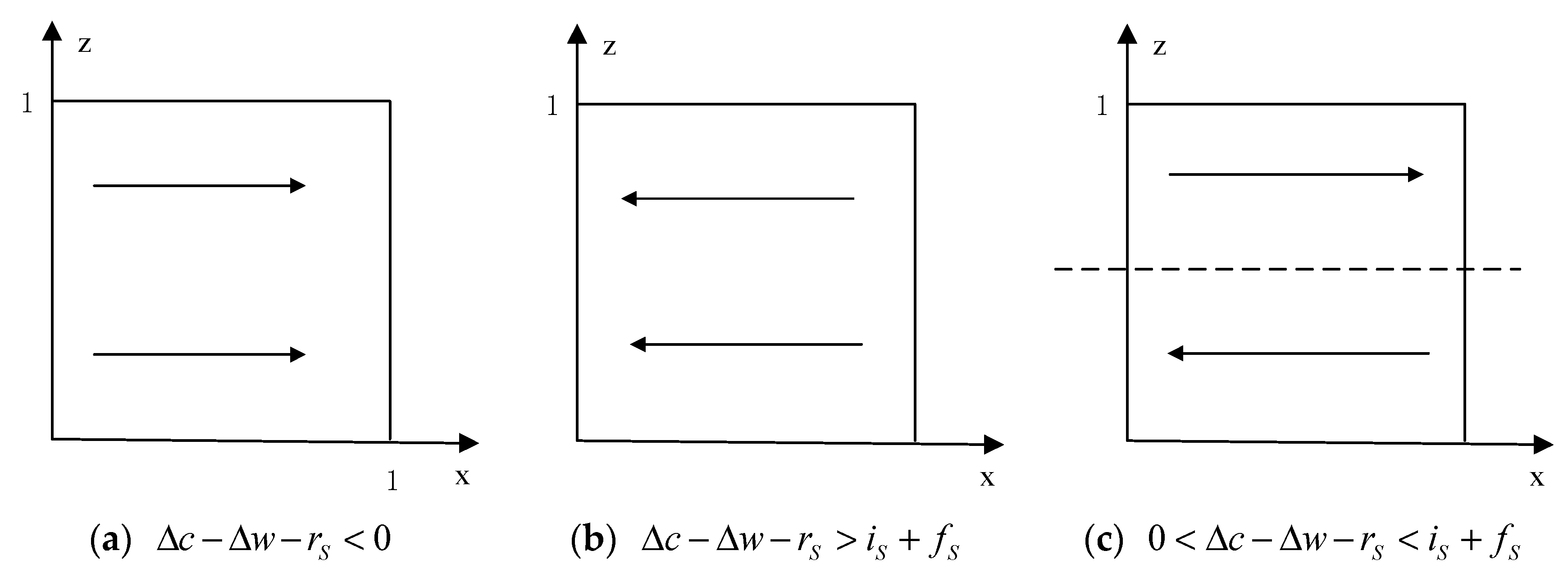
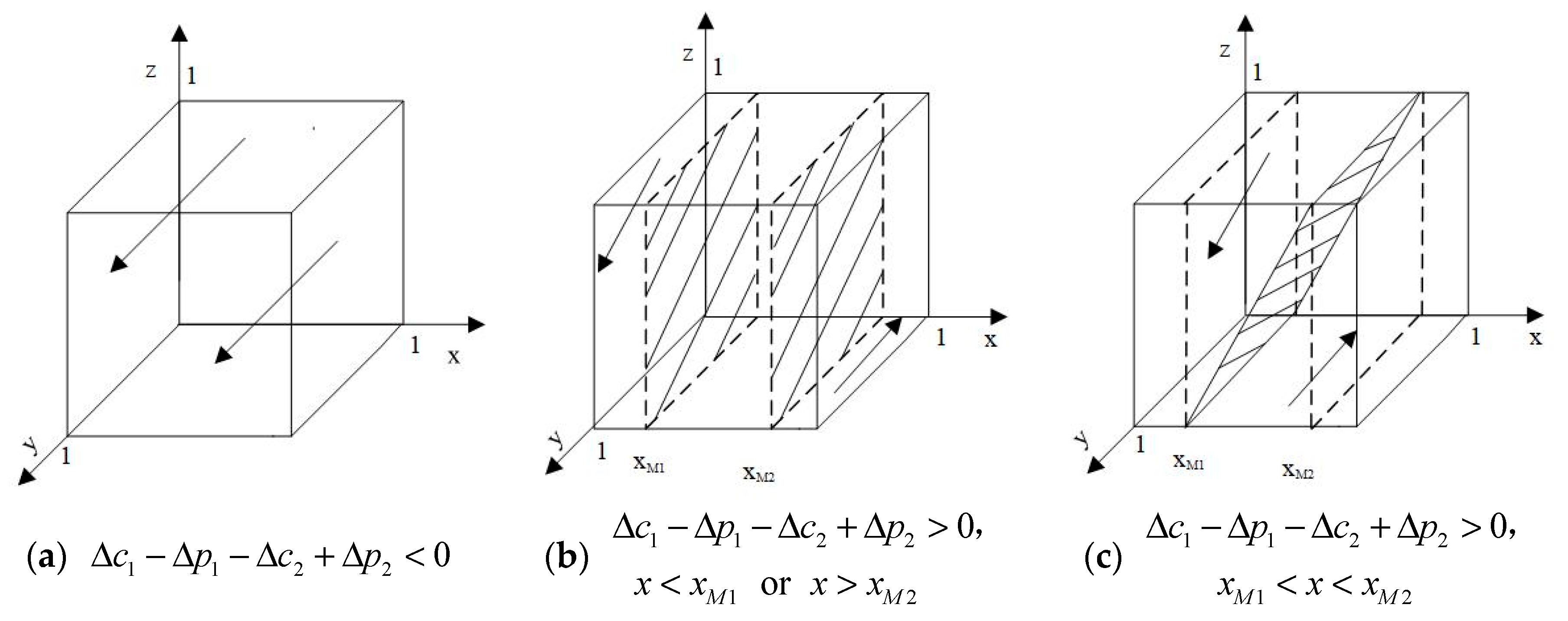
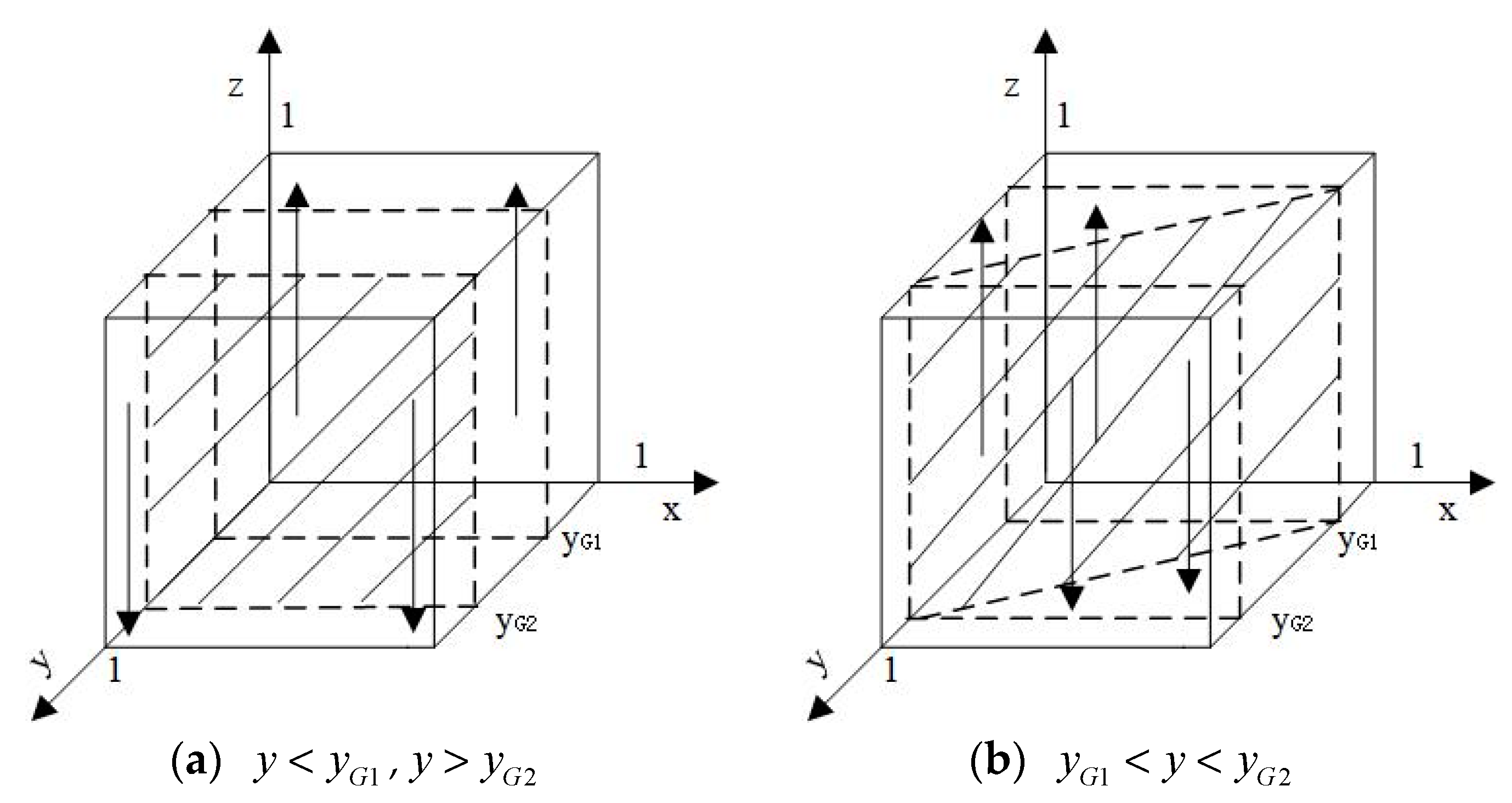
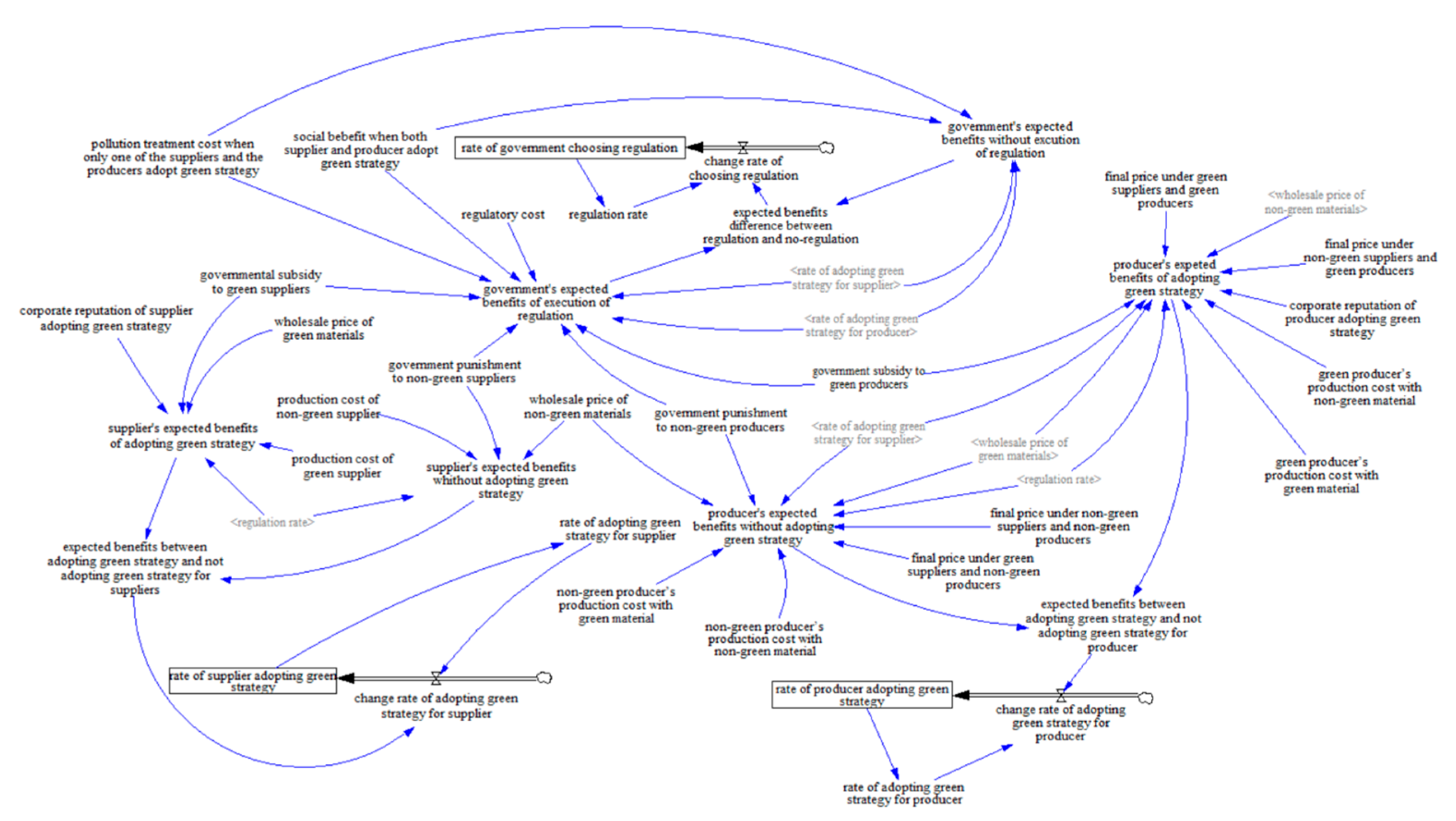
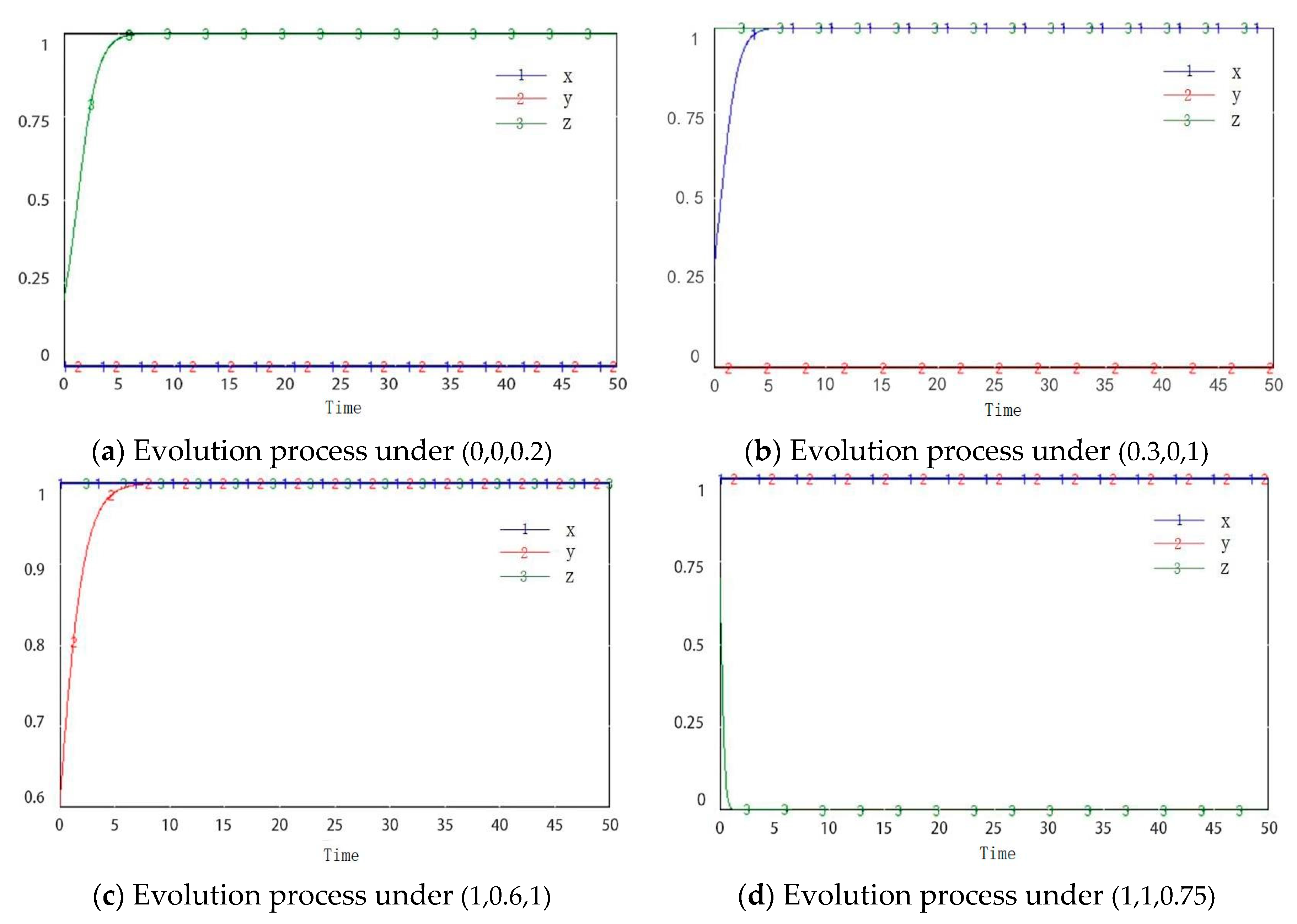
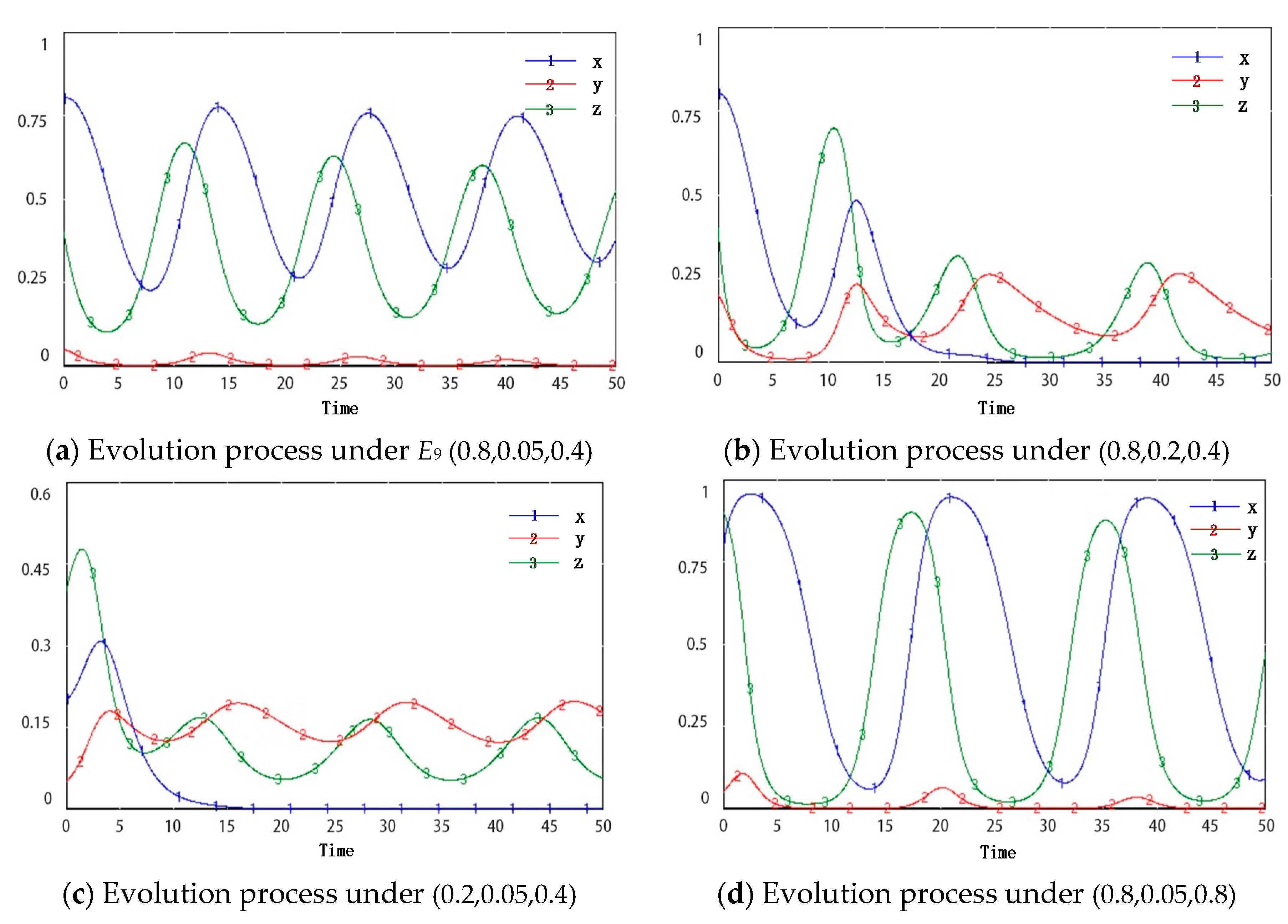
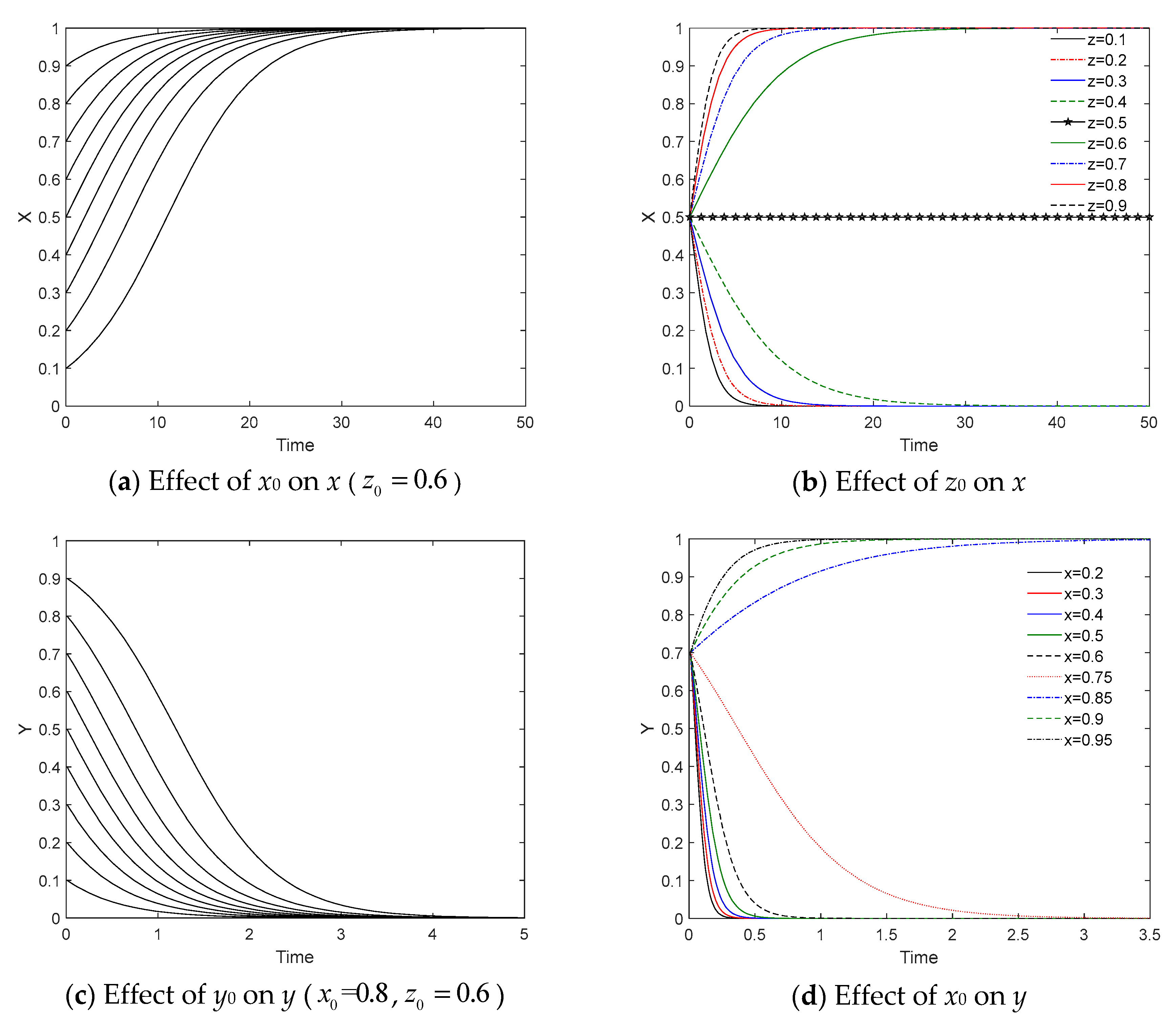
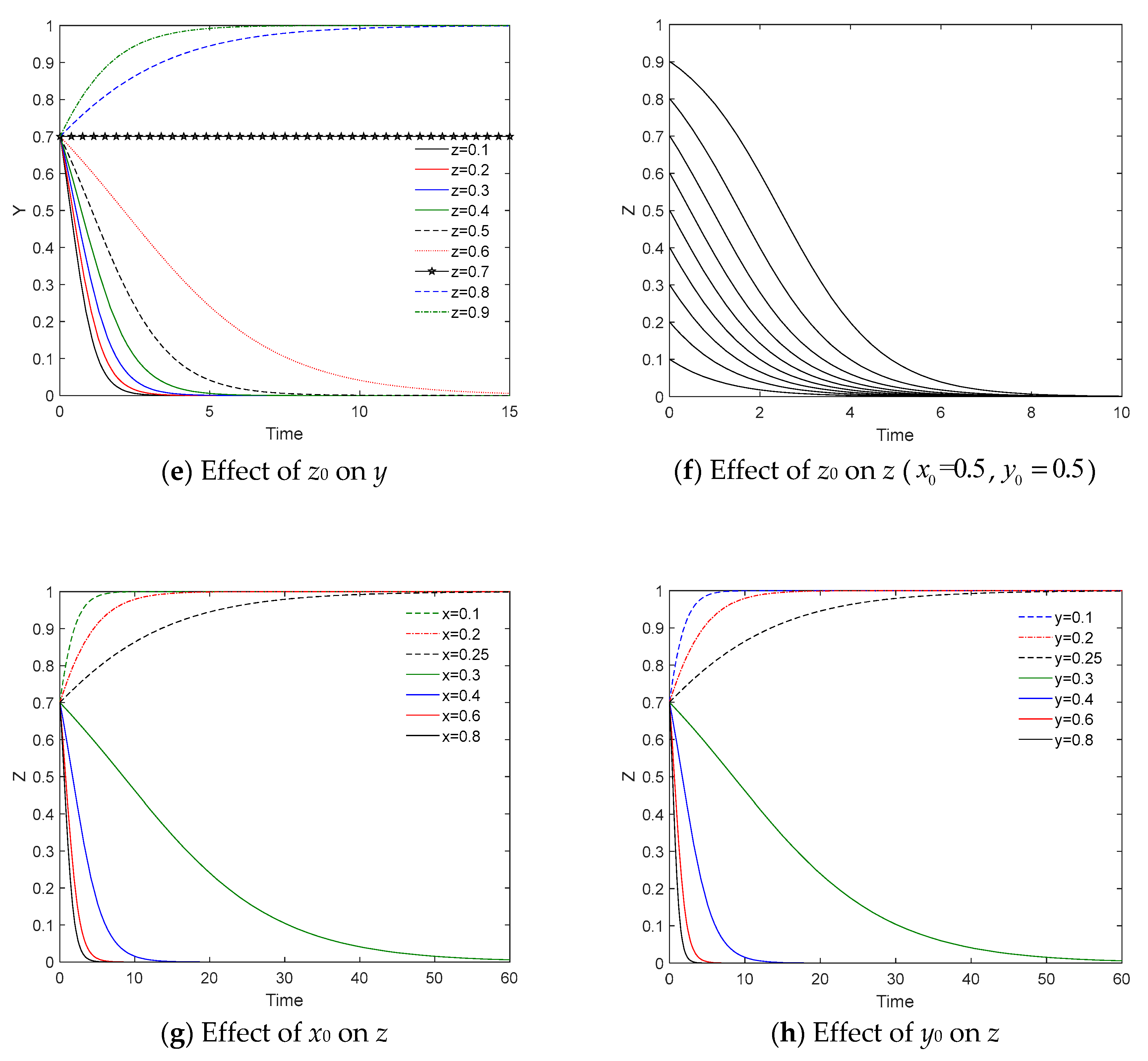
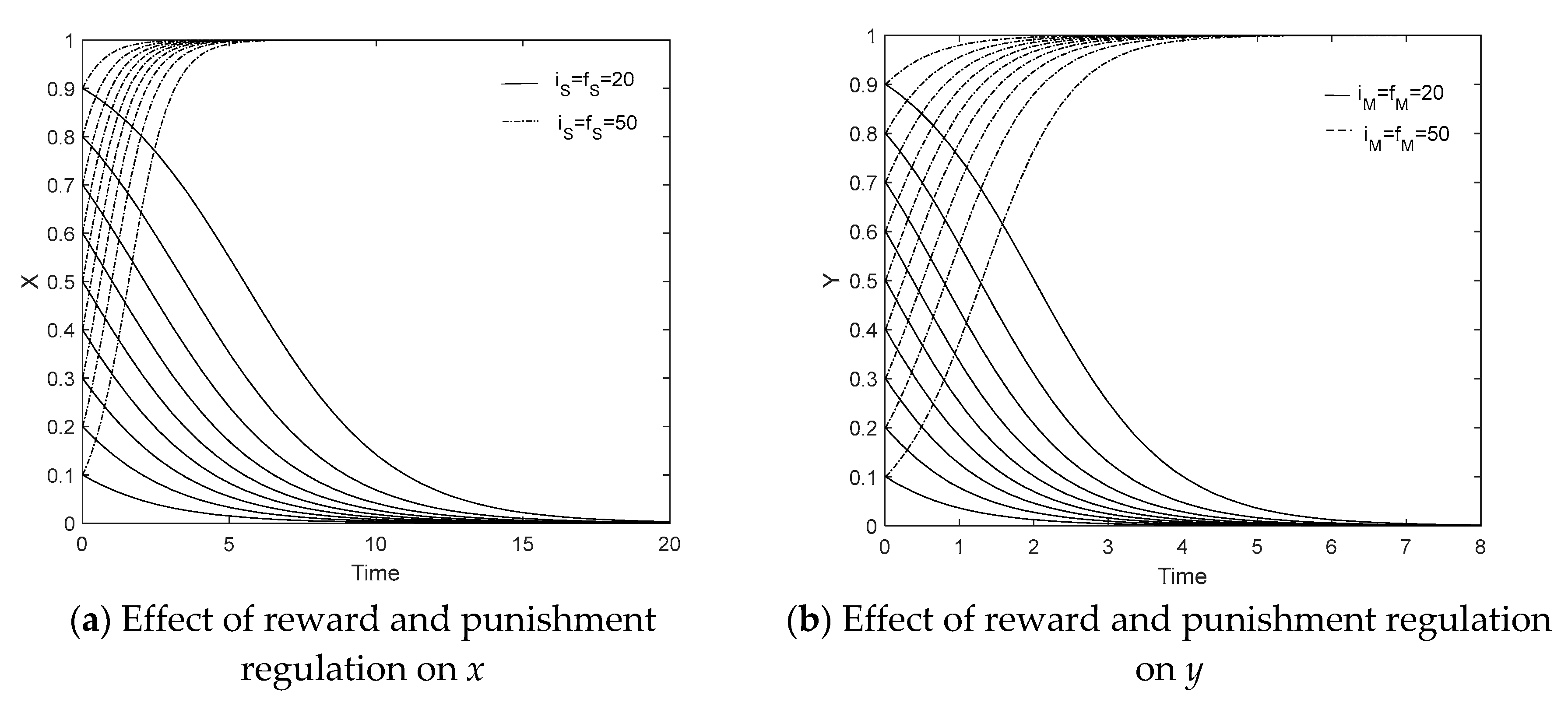
| Notations | Descriptions |
|---|---|
| Parameter | |
| The cost per unit for each non-green supplier | |
| The greening cost per unit for each green supplier | |
| The wholesale price of green materials | |
| The wholesale price of non-green materials | |
| Each green manufacturer’s production cost per unit with green materials | |
| Each green manufacturer’s production cost per unit with non-green materials | |
| Each non-green manufacturer’s production cost per unit with green materials | |
| Each non-green manufacturer’s production cost per unit with no-green materials | |
| The final price under green suppliers and green manufacturers | |
| The final price under non-green suppliers and green manufacturers | |
| The final price under green suppliers and non-green manufacturers | |
| The final price under non-green suppliers and non-green manufacturers | |
| Each supplier’s corporate reputation by adopting green strategy | |
| Each manufacturer’s corporate reputation by adopting green strategy | |
| Government subsidy to green suppliers for per unit of products | |
| Government subsidy to green manufacturers for per unit of products | |
| Government punishment to non-green suppliers for per unit of products | |
| Government punishment to non-green manufacturers for per unit of products | |
| Government regulatory cost on per unit of products | |
| Pollution treatment cost on per unit product | |
| The social benefit when both suppliers and manufacturers adopt green behaviors | |
| Variables | |
| x | The probability that the suppliers adopt green behavior |
| y | The probability that the manufacturers adopt green behavior |
| z | The probability that governments implement the regulation |
| When the Government does not Supervise the Supply Chain | |||||||
|---|---|---|---|---|---|---|---|
| Manufacturers | |||||||
| Adopt Green Behavior | Adopt Non-Green Behavior | ||||||
| Suppliers | Manufacturers | Governments | Suppliers | Manufacturers | Governments | ||
| Suppliers | Adopt green behavior | ||||||
| Adopt non-green behavior | |||||||
| When the Government Supervises the Supply Chain | |||||||
|---|---|---|---|---|---|---|---|
| Manufacturers | |||||||
| Adopt Green Behavior | Adopt Non-Green Behavior | ||||||
| Suppliers | Manufacturers | Governments | Suppliers | Manufacturers | Governments | ||
| Suppliers | Adopt green behavior | ||||||
| Adopt non-green behavior | |||||||
| Strategy | det J | tr J |
|---|---|---|
© 2020 by the authors. Licensee MDPI, Basel, Switzerland. This article is an open access article distributed under the terms and conditions of the Creative Commons Attribution (CC BY) license (http://creativecommons.org/licenses/by/4.0/).
Share and Cite
Xu, J.; Cao, J.; Wang, Y.; Shi, X.; Zeng, J. Evolutionary Game on Government Regulation and Green Supply Chain Decision-Making. Energies 2020, 13, 620. https://doi.org/10.3390/en13030620
Xu J, Cao J, Wang Y, Shi X, Zeng J. Evolutionary Game on Government Regulation and Green Supply Chain Decision-Making. Energies. 2020; 13(3):620. https://doi.org/10.3390/en13030620
Chicago/Turabian StyleXu, Jiayang, Jian Cao, Yunfei Wang, Xiangrong Shi, and Jiayun Zeng. 2020. "Evolutionary Game on Government Regulation and Green Supply Chain Decision-Making" Energies 13, no. 3: 620. https://doi.org/10.3390/en13030620
APA StyleXu, J., Cao, J., Wang, Y., Shi, X., & Zeng, J. (2020). Evolutionary Game on Government Regulation and Green Supply Chain Decision-Making. Energies, 13(3), 620. https://doi.org/10.3390/en13030620





